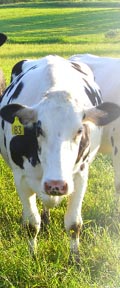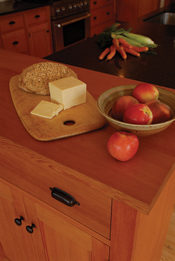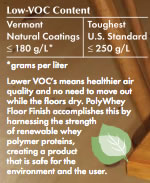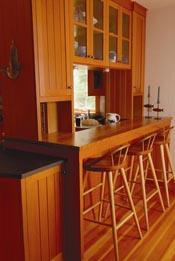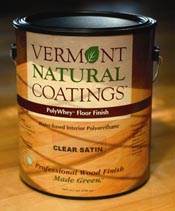
“If life gives you lemons,” goes the popular expression, “make lemonade.” That sort of resourcefulness seems to be at work for Andrew Meyer. Life gave him whey, a waste byproduct of the cheesemaking process, and believe it or not, he uses it to make waterbased wood finishes at a company called Vermont Natural Coatings. Before you ask, no, the finishes do not smell like cheese.
“I grew up on my family’s organic dairy farm in Vermont,” Andrew told me, “which is currently managed by my two younger brothers. Organic means you can’t use antibiotics, herbicides, pesticides or synthetic fertilizers on crops the animals eat. Also, the animals must be pasture fed and can’t be kept in confined areas. In northeast Vermont, there is still a strong agriculture community and a movement to develop a healthy food system in an economy that is based on food and agriculture. We’re part of that.
“I took environmental studies at University of Vermont, got a job in the department of agriculture, then worked in Washington, DC for Senator Jim Jeffords advising on agricultural policy. While I was there in the late 1990s, the food science department of the University of Vermont came to the senator asking for funding for research into using whey, a byproduct of cheese making, to create waterbased finishes for wood.
“As a staffer, I was helping assess the validity of the requests, including this one. Senator Jeffords was interested in whatever would benefit a diverse agricultural economy, since Vermont agriculture couldn’t compete with the giant farms of the Midwest. We needed to diversify, and this seemed like a great fit, because in addition to our farms, we have a strong tradition of woodworking. It took the researchers about five years to come up with a patented product they felt was viable.”
Why whey? “Whey is a by product of cheesemaking,” Andrew explained. “When you press cheese, the liquid that comes out is whey, which consists of water, fats and proteins not captured by the cheesemaking process. We take the whey, isolate the proteins and add them to a waterbased formulation. They form a very strong binding agent which can replace some of the binders that are typically added to wood finish.
“It’s the whey that contributes so heavily to the durability of our finishes. Lab testing shows that our whey-based finishes have superior durability compared to some of the other waterbased finishes in the field. For the user, our coatings dry within about two hours and have a neutral odor that most users find essentially nonexistent.”
I asked him how this is different from the milk paint we have all heard about. “We’ve found that whey protein simply makes a stronger binding agent than casein, which is at the heart of milk paint. The upshot is you get a substantially more durable coating. Of course, casein-based milk paint is not clear. Our whey-based coatings are.
“In 2004, I moved back to Vermont and negotiated an exclusive license to manufacture and sell these finishes. One of our owners is one of the original researchers who came up with this formula, and one employee is a formulator from the coatings industry.
“We built a facility in Hardwick in 2006 and developed a processing line to create and package the finish under the parameters of the patent. Though we are large enough to be a significant player in the field, we are also a small enough company to make custom finishes for furniture makers. A lot of furniture companies have unique spray applications that they are unwilling to change, and we can formulate to fit their needs and desires.
“In general, the wood coatings industry is shifting toward safer finishing products. The challenge is to create products that actually work as well as their predecessors. The advantage we have is that our finish is performing at such a high level that it is considered a high performance product. Our coatings flow out well, dry quickly and, thanks to a high solids content, may require fewer coats than some other traditional finishes.
“We currently offer clear floor finish in satin and semi-gloss, and furniture finish in satin, semi-gloss and gloss. Like most waterbased coatings, ours dries crystal clear and will not yellow over time. You can put it over either oil-based or waterbased stains, and over other finishes, including older existing finishes. For instance, you could, after good cleaning and mild abrasion, use it to recoat kitchen cabinets.
“From the homeowner to the contractor, one thing we hear consistently is that the finish applies very well and easily with brushes, paint pads, lamb’s wool and, of course, any type of spray equipment. Our coatings are perfect for people who do their own finishing of both furniture and floors, and we sell to homeowners, woodworkers and contractors.
“There are currently about 45 stores in 13 states around the country selling our coatings, and we are actively looking for more dealers. Often you can find us at stores that specialize in ecologically sound products, but more and more we are finding non-chain lumberyards and hardware stores more interested in carrying our greener line of products. In a pinch, you can always order direct from the website.
“At present, we are a small company with just five employees, and we want to maintain our presence in rural Vermont and create jobs here. However, we also want to make sure Vermont Coatings are available throughout North America for those who want finishes that smell better, are less harmful and are easier to apply. We’ll grow to whatever size we need to be to serve our market without getting too large to stay in touch with what our customers want.
“We’re a new product; try it,” suggests Andrew. “We want you to experience what it is like using Vermont Natural Coatings, and we think you’ll walk away feeling as excited about whey-based finishes as we are.”
